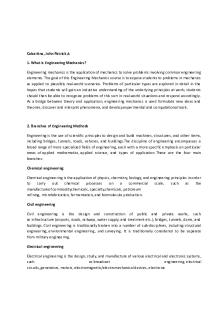Karen Horney Theory of Personality all the basic terms and definition PDF

| Title | Karen Horney Theory of Personality all the basic terms and definition |
|---|---|
| Course | AB Psychology |
| Institution | Messiah College |
| Pages | 2 |
| File Size | 125.8 KB |
| File Type | |
| Total Downloads | 36 |
| Total Views | 125 |
Summary
Theory of Personality all the basic terms and definition...
Description
The basic evil is invariably a lack of genuine warmth and affection.
-Karen Horney
Neurotic Needs and Trends / Psychoanalytic
Neurotic Trends neurotic trends evolve from and elaborate on the self-protective mechanisms, we can see similarities with our earlier descriptions. The neurotic trends involve compulsive attitudes and behaviors; that is, neurotic persons are compelled to behave in accordance with at least one of the neurotic trends.
Social Theory - People who do not have their needs for love and affection satisfied during childhood develop basic hostility toward their parents and, as a consequence, suffer from basic anxiety - Neurotics’ compulsive behavior generates a basic intrapsychic conflict that may take the form of either an idealized self-image or self-hatred. - The idealized self-image is expressed as (1) neurotic search for glory, (2) neurotic claims, or (3) neurotic pride Basic Anxiety: The Foundation of Neurosis - Basic hostility breaths basic anxiety - A Pervasive feeling of loneliness and helplessness etc.; foundation of neurosis Managing Basic Anxiety to manage this anxiety, Horney initially conceptualized four general ways of managing this o o o o
Securing Affection Submissiveness Attaining Power Withdrawing
Neurotic Needs / Defense Mechanisms Ten irrational defenses against anxiety that become a permanent part of personality and that affect behavior. 6. Affection and approval 7. A dominant partner 8. Power 9. Exploitation 10. Prestige
1. 2. 3. 4.
5.
Movement toward other people—the compliant personality, Movement against other people—the aggressive personality, Movement away from other people— the detached personality. The Expression of All Three Trends In the person who is not neurotic, all three trends can be expressed as circumstances warrant. A person may sometimes be aggressive, sometimes compliant, and sometimes detached. The trends are not mutually exclusive and can be integrated harmoniously within the personality. The normal person is flexible in behaviors and attitudes and can adapt to changing situations
Admiration Self- sufficiency Achievement or ambition Perfection Narrow limits of life
The Idealized Self- Image For normal people, the self-image is an idealized picture of oneself built on a flexible, realistic assessment of one’s abilities. For neurotics, the self-image is based on an inflexible, unrealistic self-appraisal idealized self-image for the same purpose as normal people do: to unify the personality. But their attempt is doomed to failure because their self-image is not based on a realistic appraisal of their strengths and weaknesses. Instead, it is based on an illusion, an unattainable ideal of absolute perfection. Tyranny of the Shoulds / Need a Perfection An attempt to realize an unattainable idealized self-image by denying the true self and behaving in terms of what we think we should be doing. Externalization / Drive toward Vindicate Triumph A way to defend against the conflict caused by the discrepancy between an idealized and a real self-image by projecting the conflict onto the outside world. Neurotic Ambition The neurotic’s self-image is an unsatisfactory substitute for a reality-based sense of selfworth. The neurotic has little self-confidence because of insecurity and anxiety, and the idealized self-image does not allow for correction of those deficiencies. It provides only an illusory sense of worth and alienates the neurotic from the true self. Feminine Psychology To Horney, a revision of psychoanalysis to encompass the psychological conflicts inherent in the traditional ideal of woman hood and women’s roles...
Similar Free PDFs

Karen Horney
- 2 Pages

Karen Horney - apuntes
- 3 Pages

Capítulo 7 - Karen Horney
- 8 Pages

Karen Horney - Apuntes u-1
- 2 Pages

C6 Karen Horney - Lecture Notes
- 2 Pages
Popular Institutions
- Tinajero National High School - Annex
- Politeknik Caltex Riau
- Yokohama City University
- SGT University
- University of Al-Qadisiyah
- Divine Word College of Vigan
- Techniek College Rotterdam
- Universidade de Santiago
- Universiti Teknologi MARA Cawangan Johor Kampus Pasir Gudang
- Poltekkes Kemenkes Yogyakarta
- Baguio City National High School
- Colegio san marcos
- preparatoria uno
- Centro de Bachillerato Tecnológico Industrial y de Servicios No. 107
- Dalian Maritime University
- Quang Trung Secondary School
- Colegio Tecnológico en Informática
- Corporación Regional de Educación Superior
- Grupo CEDVA
- Dar Al Uloom University
- Centro de Estudios Preuniversitarios de la Universidad Nacional de Ingeniería
- 上智大学
- Aakash International School, Nuna Majara
- San Felipe Neri Catholic School
- Kang Chiao International School - New Taipei City
- Misamis Occidental National High School
- Institución Educativa Escuela Normal Juan Ladrilleros
- Kolehiyo ng Pantukan
- Batanes State College
- Instituto Continental
- Sekolah Menengah Kejuruan Kesehatan Kaltara (Tarakan)
- Colegio de La Inmaculada Concepcion - Cebu



![[Theories of Personality] Chapter 6 Karen Horney](https://pdfedu.com/img/crop/172x258/xdz8yk62n69e.jpg)






